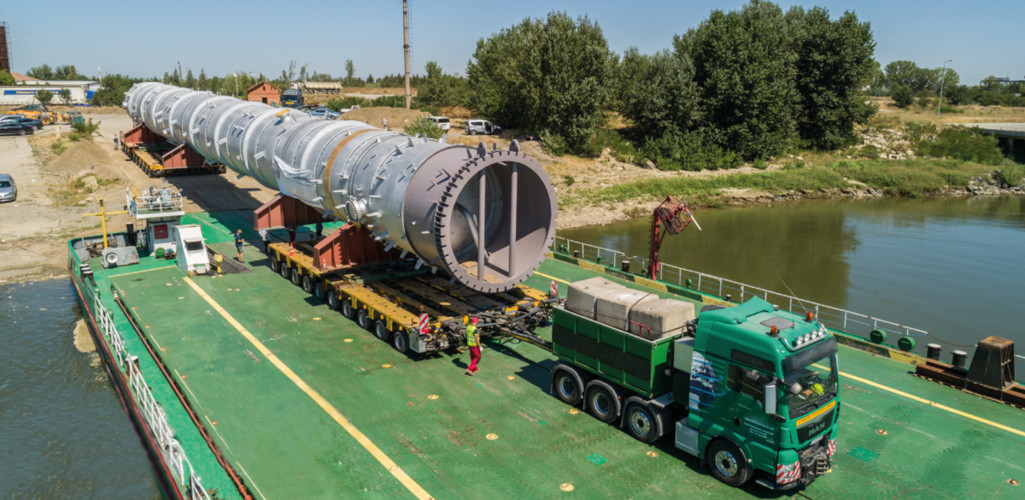Lack of Standardization, Staff Shortages Complicate Project Trucking

By John Bensalhia
Permitting problems, trucker shortages and crumbling infrastructure all threaten the growth of the European project cargo haulage industry. In this feature story from Issue 4 of Breakbulk Magazine, we examine how operators and organizations are working with regulators to ensure the industry remains attractive and progressive.
Traveling around Europe, on the face of it, the heavy transport market has much going for it and a rosy future.
LASO is a company that works all around Europe, with offices, personnel and equipment in Portugal, Spain, Italy, France, Slovenia, Germany, The Netherlands, UK, Morocco and Mozambique. “By analyzing our day-to-day business, we have a sense of feeling for the market,” explained Francisco Ruiz Miranda, director and managing director at LASO. “Today, there is a very high demand for renewables, construction equipment and everything related to the energy market, but also with the post-pandemic activation, the outlook looks promising.”
Ton Klijn, director of ESTA, added that overall, the heavy transport market is in pretty good shape, with many companies very busy. “They are driven by renewable energy, infrastructure investment and industrial markets – and given an extra uplift by the growing moves towards off-site construction.”
 Meanwhile, Riza Gögüs, business development manager of projects at Alexander Global Logistics, spotlighted two trends: “There is a very high level of competition of freight forwarders and haulage companies,” he said, noting that there is a paradox with the second trend. “There is a high demand for employees with professional competence and know-how.”
Meanwhile, Riza Gögüs, business development manager of projects at Alexander Global Logistics, spotlighted two trends: “There is a very high level of competition of freight forwarders and haulage companies,” he said, noting that there is a paradox with the second trend. “There is a high demand for employees with professional competence and know-how.”
Scratch the surface, however, and it’s clear that there are concerns about the sector. “While there is demand for employees, the problem is that there are hardly any available on the market,” Gögüs said.
Real world issues are also obstacles to the sector reaching its full potential: “Unfortunately, we also see uncertainty and delays in the market, as a result of the conflict in Ukraine,” Ruiz Miranda said.
Klijn added that there are specific problems that the authorities in Brussels and the national government urgently need to address to avoid long-term harm to the European industry.
“Heavy transport as an industry is small compared to many, but our members are a crucial part of global supply chains. For example, and put simply, the energy transition will not happen if we are unable to transport and erect wind turbines.
“Currently, the problems are at their worst in Germany, but the situation is very similar in a great many European countries - namely weak and poorly maintained infrastructure and the absurd difficulty and often very long delays in obtaining permits for abnormal road transport.”
National Problems Need Addressing
There are also serious issues in individual markets. Klijn highlighted problems in the Netherlands: “The government’s action to radically reduce the country’s high level of nitrogen emissions has stalled many construction and transportation projects, a position made worse by shortage of site workers such as crane operators.”
In Italy, Klijn said that many local authorities are reluctant to award permits for heavy transport: “This is due to fears about the strength of roads and bridges following the Genoa bridge tragedy in 2018.” French transport companies, meanwhile, complain that the routes for heavy transport identified by local administrations often do not connect to each other.
Then in the UK, the Heavy Transport Association - an ESTA member - is one of a number of organizations that have been complaining about how the regulations are interpreted and enforced differently by local police forces, creating delays and uncertainty.
“In addition, there are the panoply of rules and regulations governing marking and lighting, escort vehicles, the language requirements of drivers and more. All of the above puts up costs and means that the industry is less efficient and less safe,” Klijn said.
With respect to European regulations, Gögüs noted that there are three main areas of attention: “Obtaining the necessary transport permit is the biggest problem in Europe. The run time is approximately six weeks for heavy and special cargo.”
“Secondly, the staff must be increased by new employees to reduce the processing time. And finally, the project business must be considered in the planning of infrastructure.”
Driven to Distraction
The shortage of professional drivers in the project cargo sector has become a pressing and complex issue across Europe. Recent data from the International Road Transport Union, or IRU, indicated a critical shortage of more than 2.6 million drivers worldwide, with a 42 percent increase in driver shortages specifically in Europe from 2020 to 2021. This shortage has been particularly noticeable in countries like Romania, Poland, Germany, and the UK, where significant gaps in the driver workforce have emerged.
 “The magnitude of the problem extends beyond the immediate challenges faced by transportation companies,” said Ioana Ionita, marketing manager for Eastship.
“The magnitude of the problem extends beyond the immediate challenges faced by transportation companies,” said Ioana Ionita, marketing manager for Eastship.
“According to the IRU’s report, the scarcity of project cargo drivers has far-reaching consequences, including inflation risks, social mobility issues, and disruptions in the supply chain. Furthermore, the report shed light on the under-representation of women in the industry, with less than 3 percent of truck drivers being women across all regions. Similarly, attracting younger drivers remains a challenge, with drivers under 25 accounting for only a small percentage of the workforce.”
Ionita observed that the IRU report emphasizes a number of other problems. The first is ageing and outdated infrastructure which presents a significant challenge for project cargo drivers. “It results in longer transport routes for special cargoes, which in turn leads to extended trips for drivers.
This not only affects their work-life balance but also increases physical strain and fatigue. Investing in infrastructure upgrades is crucial to improve working conditions and optimize operations. By advocating for modernizing roads, bridges, and ports, Eastship aims to reduce travel times, minimize physical strain on drivers, and enhance overall efficiency.”
The availability of suitable truck parking areas remains limited, posing a considerable challenge for project cargo drivers. Due to legal requirements and the necessity for rest breaks, drivers spend a significant portion of their time stationary. “However, the scarcity of parking spaces, especially those suitable for project cargo, compounds the problem,” Ionita explained.
“Inadequate parking areas hinder drivers’ ability to comply with regulations, jeopardize their well-being, and cause delays in delivery. Addressing this scarcity is crucial to ensure drivers have access to safe and suitable parking, allowing them to rest and recharge effectively.”
One of the key challenges in attracting and retaining skilled project cargo drivers is unfair compensation. Ionita said that offering competitive remuneration is important to mitigate the driver shortage and maintain a satisfied and committed workforce.
While the shortage of experienced project cargo drivers necessitates investment in the development of inexperienced drivers, costly training programs pose a significant barrier. “Eastship recognizes the need to bridge this skills gap by providing extensive training programs and constant support to inexperienced drivers,” Ionita said.
“By offering accessible and comprehensive training, Eastship enables these drivers to acquire the necessary expertise and confidence for project cargo transportation. This commitment to nurturing talent plays a pivotal role in combating the driver shortage and ensuring a skilled and competent workforce for the future.”
Road to Nowhere?
Another issue in the project cargo industry is outdated equipment, which poses challenges to driver productivity and job satisfaction, leading to operational inefficiencies and the compromise of driver comfort. To address this issue, Eastship is investing in modern and well-maintained vehicles equipped with the latest technologies. “Equipping drivers with advanced tools and technologies allows them to perform their duties effectively and enhances their overall job satisfaction.”
Maintaining favorable working conditions and ensuring driver safety is also important. Drivers often face long hours on the road, demanding schedules, and physical strain. By providing a supportive work environment and also prioritizing driver safety and work-life balance, Ionita said that Eastship aims to create an environment where drivers feel valued and motivated.
“The shortage of project cargo drivers in Europe presents significant challenges for companies like Eastship, despite their efforts to offer attractive salaries, respect break times, and invest in modern equipment,” Ionita said, urging a need for a collective approach to address the underlying issues and ensure the availability of a skilled and motivated driver workforce.
“By fostering collaboration within the industry, sharing best practices, and working together to improve the accessibility and attractiveness of the profession, companies like Eastship can contribute to a sustainable and prosperous future for the project cargo sector in Europe.”
ESTA’s Klijn noted that the shortage of drivers reflects the ongoing fact that the heavy transport industry is not a high-enough priority for political leaders. For him, there are two crucial and connected changes needed. “The first is to ensure a radical improvement in the working conditions of drivers - with safe parking and decent facilities.”
“The second is for the industry to recruit from a much broader section of the population - more young people and more women. That means we are competing with other industries, and we have to be able to offer attractive wages and good quality and secure rest areas.”
While heavy road transport companies stand ready to help and support their clients with their needs, the main issue that LASO is experiencing is not new and, according to Ruiz Miranda, is getting worse.
He explained: “It is with regards to the forced relationship we must have with local authorities and entities which are the ones that should grant us the permits. This, together with the problems in infrastructure needing urgent and unexpected civil works, is jeopardizing activity and causes delays on deliveries to important projects, with consequences for the society at the end.”
At the same time, control is also an issue, with LASO witnessing more permit-free trucks on the route. “This is a problem for companies like ours, that are serious, have a brand and reputation to keep, and do things properly.”
Miranda also noted the lack of professionals that want to join the market. “This is not a sexy career at all, it demands sacrifice and knowledge,” he said, adding that youngsters do not want to try it out.
Gögüs noted that while older, experienced drivers are preferred, these will drop out more and more within the coming years and even months. “Younger generations should have more responsibilities and be given more opportunities to develop and grow on their own in the individual projects,” he said.
Cautious Optimism
 European regulations can also pose problems. Klijn argued that one issue is the huge variation and the way in which they are interpreted. The solution is straightforward - in theory: “Agree common standards and regulations, and enforce them,” he said. “For example, how hard can it be for us to agree common standards on marking and lighting? Very, apparently. As ESTA, we have been trying to achieve this for years, but everywhere we are hampered by local administrations that do not want to change.
European regulations can also pose problems. Klijn argued that one issue is the huge variation and the way in which they are interpreted. The solution is straightforward - in theory: “Agree common standards and regulations, and enforce them,” he said. “For example, how hard can it be for us to agree common standards on marking and lighting? Very, apparently. As ESTA, we have been trying to achieve this for years, but everywhere we are hampered by local administrations that do not want to change.
“More important still, however, is the need to develop a common, agreed system of electronic permitting for heavy transport and abnormal loads.”
Klijn added that if progress is to be made, proactive support from the top of the European Commission and national governments is required. Miranda agreed that unity is much needed: “We need to work together, not in the way we are working today, where we have, most of the time, no access to them and no two-way communication channel.
“We all need to realize that we are all here to serve society: the authorities by regulating and facilitating our activity, and us by fulfilling the requirements. But, again, this MUST be a two-way channel, and this applies to the entire European region.”
ESTA is cautiously optimistic about the future of Europe’s ability to properly service project cargo moves. “The poor state of much of Europe’s infrastructure is putting increasing pressure on our national politicians,” Klijn said. “In addition, there are signs that officials in Brussels are waking up to the importance of the heavy transport sector and that a coordinated and strategic approach will be essential - not for the benefit of our members alone, but for the development of a successful and sustainable European industry as a whole.”
All of Europe needs to “move towards a series of sensible and long overdue policies to support heavy transport that will have a great and positive economic impact,” he added. “The revision of the Directive 96/53/EC on weights and dimensions for road transport, currently in progress in Brussels, offers a golden chance for Europe-wide reform. We just hope that this opportunity is taken, as it should be. We have our fingers crossed.”
Despite the myriad problems, projects will not stop and project cargo from European producers will continue to be sold and exported, according to Ruiz Miranda.
“But, if we cannot perform our services on time, following the regulations and supported by the authorities, our companies will lose competitivity and we then give an advantage to other regions to take the lead. Nobody realizes the importance of all the logistic chain of actors until there is a delay that causes big budget deviations.”
John Bensalhia is a freelance writer and author with 25 years’ experience of writing for a wide range of publications and websites.
TOP PHOTO CREDIT: Eastship
